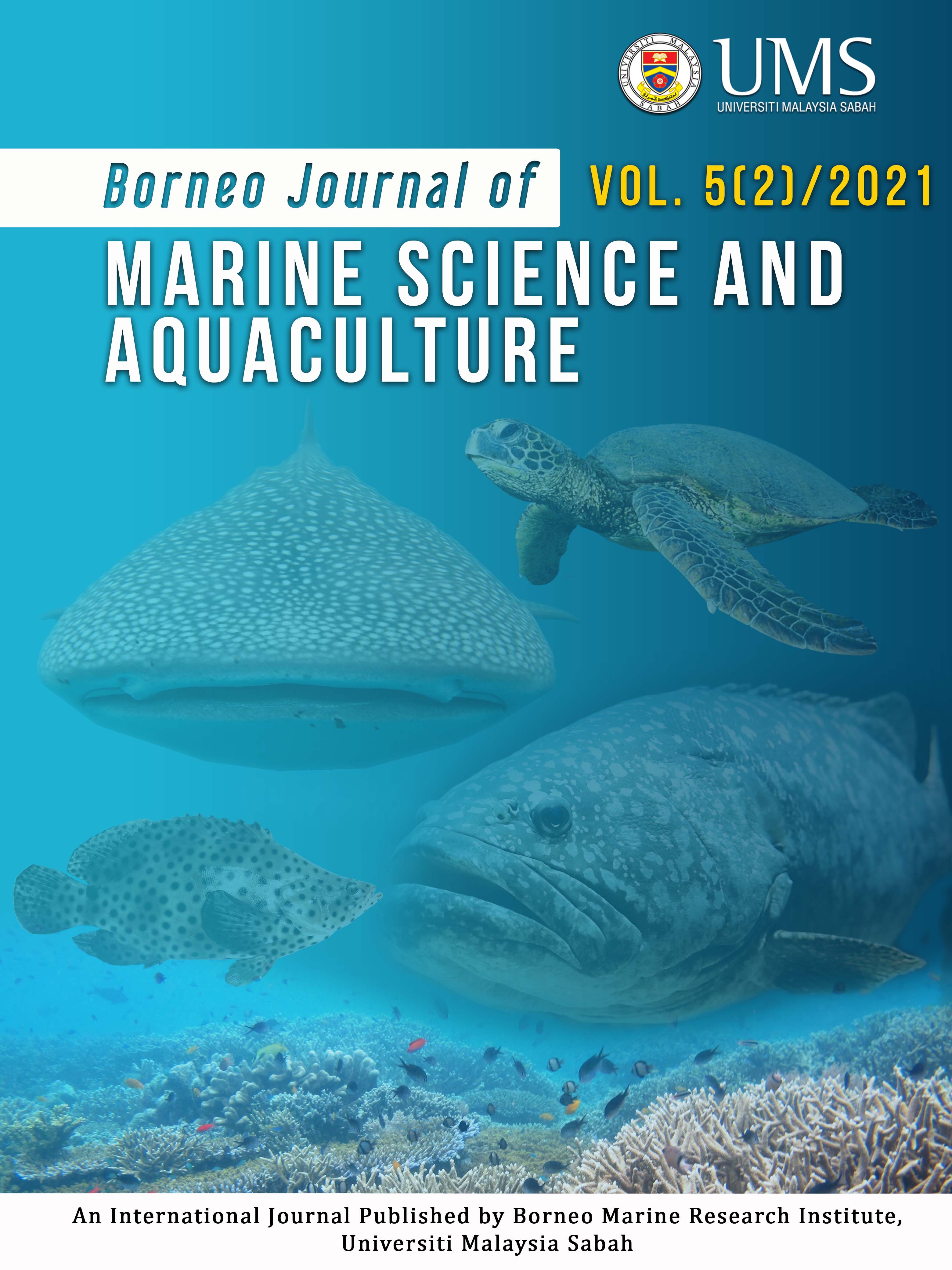Mapping coral reef using photogrammetry technique: A preliminary study at Pulau Udar Besar, Sabah, Malaysia.
DOI:
https://doi.org/10.51200/bjomsa.v5i2.2604Keywords:
image reconstruction, 3D imagery, coral growth form, Kota KinabaluAbstract
Mapping of coral reefs is useful for understanding, monitoring and tracking their development. However, studies on reef mapping in the Southeast Asian region are limited. The main objectives of this study were to 1) map the coral reefs using photogrammetry in order to create a 3D map of the reef, and 2) determine the coral growth forms and identify the corals to the lowest possible taxa from the images. Data collection was conducted on 19 and 24 January 2018. All images were captured by applying photogrammetry technique using a digital camera with waterproof housing. Image reconstruction process was performed in Agisoft Photoscan and Blender, using the structure-from-motion (SfM) algorithms to reconstruct the 2-Dimensional images into a 3D model. The reef map generated from Agisoft Photoscan is of medium quality. Coral growth forms were determined and identified to the lowest possible taxa through the images. From the images, free-living corals of the family Fungiidae were the most common coral observed in the study site. In conclusion, the output of this study shows that reef mapping is possible using a photogrammetry approach and images can be used to identify coral growth forms.
References
Agisoft LLC. (2010). Agisoft Photoscan. At: https://www.agisoft.com/pdf/photoscan_presentation.pdf. Accessed on 4 September 2020.
Agisoft LLC. (2020). System Requirements. At: https://www.agisoft.com/downloads/system-requirements/ Accessed on 6 September 2020.
Andréfouët, S. (2008). Coral reef habitat mapping using remote sensing: A user vs producer perspective. Implications for research, management and capacity building. Journal of Spatial Science, 53 (1), 113-129.
Burns, J. (2017). 3D Mapping of Coral Reefs – How to Get Started – by John Burns. Coral Reef Science & Cyberinfrastructure Network. At: https://crescyntblog.wordpress.com/2016/09/15/3d-mapping-of-coral-reefs-how-to-get-started-by-john-burns/. Accessed on 4 September 2020.
Cetin, H. (2004). Comparison of spaceborne and airborne hyperspectral imaging systems for environmental mapping. Proceedings of Tech. Commission VII, 20th ISPRS Congress 2004, Istanbul, Turkey. 1303-1313.
Chandler, J. H. & Fryer, J. G. (2005). Metric capabilities of low-cost digital cameras for close range surface measurement. Photogrammatic Record, 20 (109), 12-27.
Clark, C., Ripley, H., Green, E., Edwards, A. & Mumby, P. (1997). Cover mapping and measurement of tropical coastal environments with hyperspectral and high spatial resolution data. International Journal of Remote Sensing, 18 (2), 237-242.
Dietrich, J. (2014). Camera geometries for Structure-from-Motion mapping. At: http://adv-geo-research.blogspot.my/2014/02/camera-geometries-for-structure-from.html. Accessed on 4 September 2020.
Eakin, C. M., Nim, C. J., Brainard, R. E., Aubrecht, C., Elvidge, C., Gledhill, D.K., Muller-Karger, K., Mumby, P. J., Skirving, W. J., Strong, A.E., Wang, M., Weeks, S., Wentz, F. & Ziskin, D. (2010). Monitoring coral reefs from space. Oceanography, 23 (4), 118–133.
Fox, H. & Caldwell, R. (2006). Recovery from blast fishing on coral reefs: A tale of two scales. Ecological Applications, 16 (5), 1631-1635.
Gallagher, J. B., Chuan, C. H., Muhammad Shazwan, M. Y., Chen, N. G. & Goh, Y. M. (2016). Surface chlorophyll patchiness across Sepanggar Bay: Relationships with turbidity and depth. Transactions on Science and Technology, 3 (2-2), 421-426.
Ginsburg, R. (1994). Proceedings of the Colloquium on Global Aspects of Coral Reefs, Health, Hazards and History. Rosenstiel School of Marine and Atmospheric Science, University of Miami, Miami. 420 pp.
Hardy, C., Virata, J. & Brown, S. (2018). Easy Stony (Hard) Corals – Petcha. At: https://www.petcha.com/easy-stony-hard-corals/. Accessed on 17 May 2018.
Heery, E. C., Hoeksema, B. W., Browne, N. K., Reimer, J. D., Ang, P. O., Huang, D. et al. (2018). Urban coral reefs: Degradation and resilience of hard coral assemblages in coastal cities of East and Southeast Asia. Marine Pollution Bulletin, 135, 654–681.
Marre, G., Holon, F., Luque, S., Boissery, P. & Deter, J. (2019). Monitoring marine habitats with photogrammetry: A cost-effective, accurate, precise and high-resolution reconstruction method. Frontiers in Marine Science, 6, 276.
Miller, I. & Müller, R. (1999). Validity and reproducibility of benthic cover estimates made during broadscale surveys of coral reefs by manta tow. Coral Reefs, 18 (4), 353-356.
Morgan, J., Brogan, D. & Nelson, P. (2017). Application of structure-from-motion photogrammetry in laboratory flumes. Geomorphology, 276, 125-143.
Mumby, P. & Edwards, A. (2002). Mapping marine environments with IKONOS imagery: enhanced spatial resolution can deliver greater thematic accuracy. Remote Sensing of Environment, 82 (2-3), 248-257.
Nisha, U. (2021). Basics of Photogrammetry - GIS Resources. At: https://www.gisresources.com/basic-of-photogrammetry_2/ Accessed on 19 April 2021.
Poncet, P. & Quod, J. (2017). Underwater Coral Reef Mapping with Pix4Dmapper. Pix4D. At: https://pix4d.com/underwater-mapping-3d-coral-reefs-enhance-environmental-reefs-surveys/. Accessed on 10 November 2017.
Riddle, D. (2020). Light Intensity Requirements of Tidepool Coral: Part II – Porites lobata. At: https://reefs.com/magazine/light-intensity-requirements-of-tidepool-coral-part-ii-porites-lobata/ Accessed on 6 September 2020.
Scopélitis, J., Andréfouët, S., Phinn, S., Arroyo, L., Dalleau, M., Cros, A. & Chabanet, P. (2010). The next step in shallow coral reef monitoring: Combining remote sensing and in situ approaches. Marine Pollution Bulletin, 60 (11), 1956-1968.
Stal, C., Bourgeois, J., De Maeyer, P., De Mulder, G., De Wulf, A., Goossens, R., Hendrickx, M., Nuttens, T. and Stichelbaut, B. (2012). Test case on the quality analysis of structure from motion in airborne application. Proceedings of the 32nd EARSeL symposium 'Advances in Geosciences'. Mykonos, Greece. 11.
Ventura, D., Bruno, M., Lasinio, G. J., Belluscio, A. & Ardizzone, G. (2016). A low-cost drone based application for identifying and mapping of coastal fish nursery grounds. Estuarine, Coastal and Shelf Science, 171, 85-98.
Veron, J. E. N. (2000). Corals of the world. Vol. 1-3. Australian Institute of Marine Science. Australia.
Walford, A. (2017). What is Photogrammetry? At: http://www.photogrammetry.com/index.htm. Accessed on 4 September 2020.
Westoby, M.J., Brasington, J., Glasser, N.F., Hambrey, M.J. and Reynolds, J.M. (2012). ‘Structure-from- Motion’ photogrammetry: A low-cost, effective tool for geoscience applications. Geomorphology, 179, 300-314.
Witze, A. (2016). Marine ecologists take to the skies to study coral reefs. Nature, 534 (7605), 13-14.






